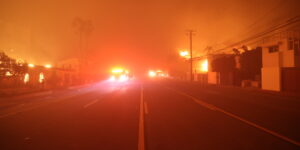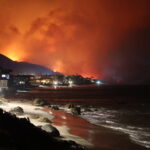It’s time for the insurance industry to be “bold” and “sexy” in creating new insurance products and services to help the world deal with extreme risks that are becoming more common, according to a global authority on managing catastrophes and other extreme risks.
“Try something new!” Dr. Erwann Michel-Kerjan exhorted attendees at the Professional Liability Underwriting Society (PLUS) International Conference in Orlando.
Michel-Kerjan, who teaches Value Creation at the Wharton School of Business and is a contributor to the World Economic Forum that publishes the annual Global Risk Survey, said that while extreme events have been thought of as low probability, this is no longer true.
Extreme events—also knows as “black swans”— are more likely than people think and will most likely continue to have real implications for insurance professionals and their clients, according to the professor.
He asked for a show of hands of how many people in the audience have dealt with a major event within the past few years. About two-thirds raised their hands.
“For the rest of you, just wait,” said Michel-Kerjan, who is managing director of the Risk Management and Decision Process Center, The Wharton School of Business, University of Pennsylvania.
He is also author of The Irrational Economist, with Paul Slovic, and At War with The Weather, and has written on terrorism risk and disaster response.
To further illustrate his point he cited a string of major natural and manmade events since 2001, including: the 9/11 terrorist attacks in the U.S., the Northeast blackout of 2003, the South Asia tsunami in 2004, the 2005 London Underground terrorist attack, Hurricane Katrina in 2005, the BP Gulf oil spill in 2006, the earthquake in China in 2008, the 2008 financial crisis, the 2010 earthquake in Chile, Superstorm Sandy in 2012 and, this year, the federal government shutdown.
“They’re happening every three months. The risk architecture is changing fast and we’ve only begun to recognize it,” he said.
While he acknowledged that some question whether the government shutdown is a “black swan” event, Michel-Kerjan said it qualifies because “when the richest economy in the world does not have an operating government, that is not good at all.”
Greater interdependency is one of the features of the new global risk architecture, he said. Expanding into new markets is good but this also increases exposures. While globalization has had a positive impact on poverty, it has also raised global risks including supply-chain concerns.
The new risk landscape is also marked by organizations being only as strong as their weakest link but this perception can skewed by the professional biases of people with the power to influence corporate decision makers. As an example, he said it is a mistake for a company to invest a lot in hiring experts to beef up cyber security without also doing human resource due diligence on those new hires to whom it is giving all of the firm’s IT secrets.
He said organizations must ask themselves where they are in their “domino chain” and realize that what happens to another organization or vendor can affect their own business.
The Wharton professor said many people today are focused on the short-term horizon, valuing immediate access to information and preferring to make quick or intuitive decisions, rather than being focused on developing strategies and making longer-term decisions that take time and require deliberation and research.
“We are making more quick decisions without always knowing the full impact,” he said.
This intuitive decision-making has certain biases, he said, including an overemphasis on whatever was the most recent crisis, an “it won’t happen to us” overconfidence, a miscalculation of the actual risk, a myopic focus on the short-term and procrastination about doing something (“we will do that next year”).
As an example, he cited what he said is short-term thinking in America about upgrading the country’s infrastructure. Having recently returned from China, he said, “New York looks like a Middle Age country compared to China” in terms of infrastructure.
In a positive sign with implications for liability underwriters, Michel-Kerjan said there is growing awareness and sense of responsibility among corporate executives about the importance of risk management. He cited a PwC survey of 1,000 CEOs in which two-thirds identified risk management as a CEO responsibility.
This recognition is also happening at the board level with more directors asking questions while also expressing anxiety about their own exposure, he said.
“Oversight and management are more integrated,” he said.
Overall, CEOs are increasingly seeing risk management as a strategic issue and not just a technical matter. “This is new,” he said.
Michel-Kerjan said liability insurance professionals must deal with issues that show up years later, a fast-changing regulatory environment such as the Affordable Care Act that can create new exposures, and clients who need to be persuaded that investment in risk management is worthwhile.
He said there is “massive opportunity” both in terms of adding social value and making money in risk management work and in helping companies prepare for the future.
He urged the insurance industry to help convince more clients to take risk management seriously by figuring out “how to make liability products and services more sexy.”
“It’s time to be bold!” he said. “Try something new!”
In response to a question, he said the industry could also do a better job of marketing itself as a “sexy” career to college students in order to attract young professionals. “Insurance makes economic growth possible,” he said, yet a career in insurance is still a “hard sell” to college students.
“You need to explain why what you are doing is sexy and why it is so important,” he told the PLUS crowd.




















 Moody’s Global P/C Outlook Now Stable Despite Past-Peak Commercial Pricing
Moody’s Global P/C Outlook Now Stable Despite Past-Peak Commercial Pricing  Reinsurers in Growth Mode Brought Capacity, Flexibility to 1/1 Renewals
Reinsurers in Growth Mode Brought Capacity, Flexibility to 1/1 Renewals  2025 Underwriting Profit and ‘Shop-a-Palooza’ Predicted for Auto Insurance
2025 Underwriting Profit and ‘Shop-a-Palooza’ Predicted for Auto Insurance  California Wildfires Will Likely Lead to Large Economic and Insured Losses
California Wildfires Will Likely Lead to Large Economic and Insured Losses 